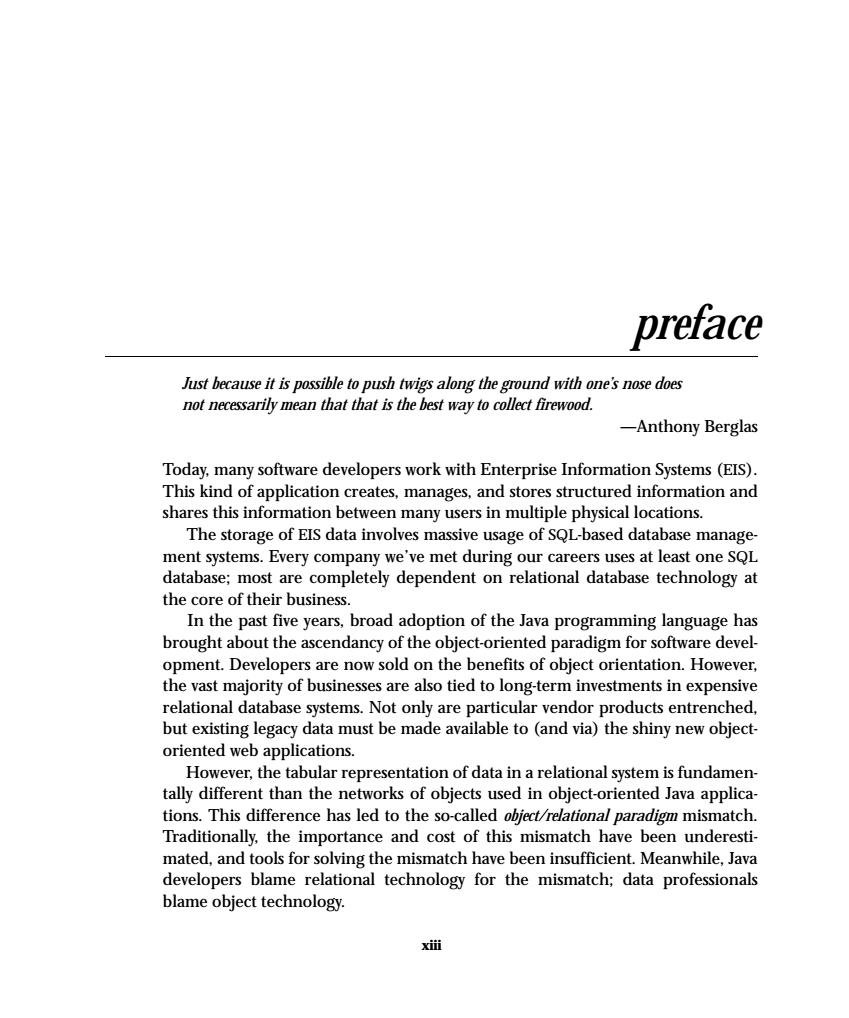正在加载图片...

preface Just because it is possible to push twigs along the ground with one's nose does not necessarily mean that that is the best way to collect firewood. -Anthony Berglas Today,many software developers work with Enterprise Information Systems(EIS). This kind of application creates,manages,and stores structured information and shares this information between many users in multiple physical locations. The storage of EIS data involves massive usage of SQL-based database manage ment systems.Every company we've met during our careers uses at least one SQL database:most are completely dependent on relational database technology at the core of their business. In the past five years,broad adoption of the Java programming language has brought about the ascendancy of the object-oriented paradigm for software devel opment.Developers are now sold on the benefits of object orientation.However. the vast majority of businesses are also tied to long-term investments in expensive relational database systems.Not only are particular vendor products entrenched. but existing legacy data must be made available to(and via)the shiny new object oriented web applications. However,the tabular representation of data in a relational system is fundamen- tally different than the networks of objects used in object-oriented Java applica- tions.This difference has led to the so-called object/relational paradigm mismatch Traditionally,the importance and cost of this mismatch have been underesti- mated,and tools for solving the mismatch have been insufficient.Meanwhile.Java developers blame relational technology for the mismatch;data professionals blame object technology. xixiii preface Just because it is possible to push twigs along the ground with one’s nose does not necessarily mean that that is the best way to collect firewood. —Anthony Berglas Today, many software developers work with Enterprise Information Systems (EIS). This kind of application creates, manages, and stores structured information and shares this information between many users in multiple physical locations. The storage of EIS data involves massive usage of SQL-based database management systems. Every company we’ve met during our careers uses at least one SQL database; most are completely dependent on relational database technology at the core of their business. In the past five years, broad adoption of the Java programming language has brought about the ascendancy of the object-oriented paradigm for software development. Developers are now sold on the benefits of object orientation. However, the vast majority of businesses are also tied to long-term investments in expensive relational database systems. Not only are particular vendor products entrenched, but existing legacy data must be made available to (and via) the shiny new objectoriented web applications. However, the tabular representation of data in a relational system is fundamentally different than the networks of objects used in object-oriented Java applications. This difference has led to the so-called object/relational paradigm mismatch. Traditionally, the importance and cost of this mismatch have been underestimated, and tools for solving the mismatch have been insufficient. Meanwhile, Java developers blame relational technology for the mismatch; data professionals blame object technology. Licensed to Jose Carlos Romero Figueroa <jose.romero@galicia.seresco.es>